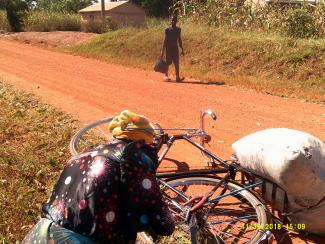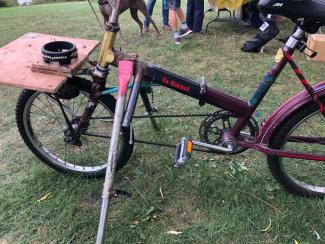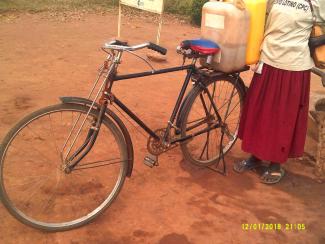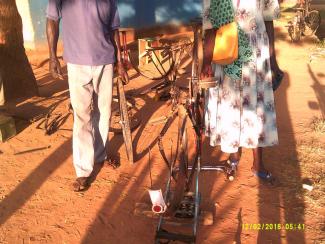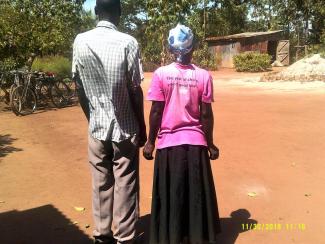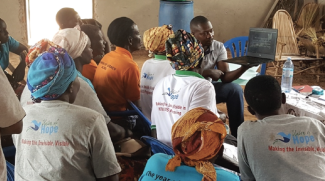In this podcast, Janet Otte, from Tororo, Uganda, discusses the research she conducted with a number of 'bicycle-for-development' organizations and practitioners in Northern Uganda. This episode is part of a three-episode series by the Sport, Social Justice, and Development Podcast (hosted by Lyndsay Hayhurst, Julia Ferreira Gomes, Jess Nachman, and Mitchell McSweeney) focused on the varying uses of bicycles to contribute to development goals (this episode hosted by Mitchell McSweeney).
Dr. Lyndsay Hayhurst, Associate Professor at York University and member of the Mobilizing Sport and Sustainability Collective, explains gender-based violence, intersectional environmentalism, and the Bicycles for Development movement, with an example from her work with collaborators in Nicaragua.
As a White settler, heterosexual, able-bodied, cisgender, Canadian woman, Hayhurst would like to acknowledge the privileges and advantages that emanate to her as a result of colonization; as well as her residence in a politically stable country which gave her the opportunity to co-develop this video with colleagues and collaborators.
Hayhurst would also like to highlight the importance of critically reflecting on one’s social position and unequal power relations when engaging with decolonial feminist approaches to digital participatory research to try and uphold non-Western knowledge forms to promote coalition-building (see Nachman et al., in press; Lugones, 2011). Despite this video featuring her narration, it is important to note the collaborative research informing the video is guided by diverse perspectives on issues pertaining to gender-based violence, climate change, mobility justice and sport for development.
Hayhurst would also like to express gratitude to the participants and staff from Comision Mujer Joven (CMJ) who took the time to collaborate on this study and share the stories, images and experiences that informed the production of this video. She would also like to thank and recognize the research support and collaboration provided by Lidieth del Socorro Cruz Centeno (Director, CMJ), Cecilia Eugenia Falla (translator) and Keiron Cobban (research associate/videographer). However, any errors in this material are the sole responsibility of Hayhurst.
This video was produced with UBC Studios, with particular thanks to Chris Spencer and Dr. Brian Wilson for their substantial input, direction and support. The research featured in this video was supported by the Social Sciences and Humanities Research Council of Canada Insight Grant (435-2021-1188) and a Canadian Foundation for Innovation John R. Evans Leaders Fund.
History and Context of 'Bicycles-for-Development'
Since the invention of the bicycle in 1817, bikes have had a long and varied history of usage in social and cultural contexts, from simple transportation, engaging in exercise, to reducing environmental impact of autombile emissions. Today, the bicycle has been claimed by large international organizations, such as the United Nations and World Health Organization, to be a sustainable tool for recreation, cost-efficient, and most notably, may potentially contribute to development goals. With the onset of COVID-19, the United Nations suggested that bicycles might play a significant role in post-COVID-19 'green recovery'. In addition, reports of a bicycle boom due to COVID-19 lockdowns, reduced transportation options, and the bicycle's utility for outdoor activities, were seen in both the global North and the global South. Now, it appears that the bicycle boom is set to last into the future.
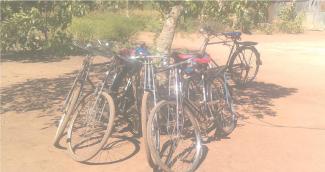
The United Nations Environmental Programme has gone as far to say that "investing in pedestrians and cyclists - who often make up the majority of citizens in a city - can save lives, help protect the environment and support poverty reduction." Governments, corporations, communities, individuals, and nongovernmental organizations around the world have taken up the bicycle for the purposes of numerous development goals, ranging from environmental sustainability, to providing enhanced mobility for women and girls, to challenging assumptions around cycling identities, all the way to hosting bicycle mechanical workshops for individuals and under-represented groups to engage in livelihood activities.
Hundreds of organizations around the world are using bikes to achieve development aims. A search of BFD organizations conducted in 2017-2018 by members of the BFD research team revealed some interesting contextual notes about the operation of such organizations, including:
- A majority of BFD organizations were created in the US, Canada, Australia, and the UK, whereas the bulk of bicycles are distributed in regions of Africa, Central America, and South Asia.
- Social goals varied by organization and location, including attention to poverty, enhancing mobility, empowerment, gender equality, access to education, health promotion, and market accessibility.
- Most organizations operated internationally, although some primarily focus on domestic contexts (e.g., Canada).
- BFD organizations operated in multiple ways. For example, they: (1) collected used, donated, old and/or broken bicycles and bicycle parts to be shipped to marginalized areas of the global North or – which is most often the case – the global South for use; (2) used bicycles for development programming (promoting girls’ empowerment) in the case of community-driven BFD organizations; (3) sold bicycles at low-costs (whether manufactured, donated or built) to local bike shops in marginalized areas of the global South to spur local economies and invest in community employment; and (4) used proceeds of sold bicycles to open bicycle shops, train bicycle mechanics, and more generally invoke a costfriendly form of mobility for populations with limited access to transportation resources and options (see Ardizzi et al., 2020).
The below map provides a visual of the number of organizations implementing bicycle-related initiatives and agencies who fund such initiatives. The picture above is a map of BFD organizations operating around the world. The numbered buttons represent a BFD organization, funder, or partner and their headquarters location. The red lines drawn represent where these organizations implement BFD programs, while the blue lines drawn represent the flow of money that funders provide to BFD organizations and programs. Currently, the BFD map is undergoing updates and maintenance, and a link to the updated map and list of organizations and funders will be posted on this page when the map is accessible.
Based on the international, regional, and community-based bicycle-related development projects taking place around the globe, it appears that the use of 'bicycles-for-development' (BFD) (i.e., the use of bicycles to contribute to development goals) holds a significant role in the international development landscape. But do bicycles contribute to development? And if so, what are the complexities, unintended consequences, and issues associated with the BFD movement?
To see a description of the images above, hover over the image with your mouse or mousepad.
Unpacking BFD: Potential, Challenges, and Unintended Consequences
Our BFD research team, led by Dr. Lyndsay Hayhurst at York University in Toronto, Ontario, Canada, has been conducting research into BFD since 2016. In the first phase of the BFD study from 2017-2021 or 'BFD 1.0', the title of our research project was "Cycling Against Poverty? Researching a Sport for Development Movement and an ‘Object’ in/for Development." The BFD research team carried out data collection in five locations during BFD 1.0, including Canada, Nicaragua, Uganda, India, and South Africa, and four overarching research questions were utilized to guide fieldwork:
- What development roles do bicycles play in disadvantaged communities in Canada, Nicaragua, South Africa, India, and Uganda?
- To what extent does BFD enhance and uphold local sustainable community development efforts in global South countries, and marginalized communities in the global North?
- How do bicycles enter, move within, and leave these communities? Who has access to the bicycles and the benefits of bicycles, and who does not?
- What do the 'life histories' of bicycles reveal about the globalization of development, aid, and work in local communities?
The two columns below outline the stages of research that took place and key findings.
BFD 1.0 Stages of Research and Summary of Key Findings
BFD 1.0 Brief Report
Academic Articles
The BFD research team has also published multiple academic articles in peer-reviewed journals based on the research conducted during BFD 1.0. Please click on the below boxes to access these articles and to learn more about our research. If you are interested in any of these articles, but are unable to access them, please contact us.
In my mind, bicycles are really important for women. Especially for women that are single mothers. Because you’re a single mother, you are working. You have to do the housework and also you have to take care of the children. So [you] really need a lot of time […] So single mothers […] if they were able to use a bicycle, then they would be able to [do] housework and they would be able to take those children to school. Having a bicycle will make that easier.
- (Quote from Grace, research participant involved with Uganda fieldwork; from Third World Quarterly article led by Lyndsay Hayhurst)
What's Next?
Based on the first phase of BFD research from 2017-2021, there remains a pressing need to understand further the role of the bicycle for development purposes, especially with the onset of COVID-19 and post-pandemic recovery. The BFD research team at York University is conducting a second phase of research, 'BFD 2.0', into bicycles use in Nicaragua, Uganda, and Canada (2022-2026). In this phase of the project, a specific focus is on: (1) gender-based violence prevention; (2) social entrepreneurship for women and girls; and (3) the roles of women and girls in achieving environmental sustainability – particularly in upholding a greener recovery from COVID. The following video contains findings from BFD 2.0 work in Nicaragua.
Dr. Lyndsay Hayhurst, Associate Professor at York University and member of the Mobilizing Sport and Sustainability Collective, explains gender-based violence, intersectional environmentalism, and the Bicycles for Development movement, with an example from her work with collaborators in Nicaragua.
As a White settler, heterosexual, able-bodied, cisgender, Canadian woman, Hayhurst would like to acknowledge the privileges and advantages that emanate to her as a result of colonization; as well as her residence in a politically stable country which gave her the opportunity to co-develop this video with colleagues and collaborators. Hayhurst would also like to highlight the importance of critically reflecting on one’s social position and unequal power relations when engaging with decolonial feminist approaches to digital participatory research to try and uphold non-Western knowledge forms to promote coalition-building (see Nachman et al., in press; Lugones, 2011). Despite this video featuring her narration, it is important to note the collaborative research informing the video is guided by diverse perspectives on issues pertaining to gender-based violence, climate change, mobility justice and sport for development.
Hayhurst would also like to express gratitude to the participants and staff from Comision Mujer Joven (CMJ) who took the time to collaborate on this study and share the stories, images and experiences that informed the production of this video. She would also like to thank and recognize the research support and collaboration provided by Lidieth del Socorro Cruz Centeno (Director, CMJ), Cecilia Eugenia Falla (translator) and Keiron Cobban (research associate/videographer). However, any errors in this material are the sole responsibility of Hayhurst.
This video was produced with UBC Studios, with particular thanks to Chris Spencer and Dr. Brian Wilson for their substantial input, direction and support. The research featured in this video was supported by the Social Sciences and Humanities Research Council of Canada Insight Grant (435-2021-1188) and a Canadian Foundation for Innovation John R. Evans Leaders Fund.
Additional Resources
BFD: Community of Practice Exploration Workshop Recording
The above video is from a BFD: Community of Practice Exploration workshop held by the York University BFD research group in collaboration with World Bicycle Relief and the Massachusetts Institute of Technology D-Lab.
BFD 1.0 Digital Story
The above video is a digital story that was created based on research findings from the first phase of the BFD project (2017-2021). The video was created by Julia Ferreira Gomes with support and collaboration from Mitchell McSweeney, Jessica Nachman, Janet Otte, Eyul Patrick, Donna Tara Parytci, Lidieth del Socorro Cruz Centeno, Charles Chiu, Alix Aylen, and participants from Union of Hope, Charlie’s Freewheels and Asociación Movimiento de Jóvenes de la Isla de Ometepe.
Sport, Social Justice, and Development Podcast: BFD Episodes
Other BFD-related podcast episodes from the Sport, Social Justice, and Development podcast can be found here.
Other Bicycle-related Resources
The BFD research team is not the only group investigating the possibilities and pitfalls of the bicycle for development. Below are some links to important work by other organizations, researchers, individuals, and media articles on the bicycle's utility for development aims:
Cycling to success: A road to empowerment for rural girls in India
'A Mountain Bike Changed My Life'
‘I can pedal faster than a man can run’ – how bikes are changing the dynamic on Africa's roads
New Canadians find new rides with bicycle donation program
Cadbury Bicycle Factory turns 10
Research team
This project is led by Dr. Lyndsay Hayhurst, School of Kinesiology and Health Science, York University. Co-investigators of the project include Dr. Brian Wilson, School of Kinesiology, University of British Columbia; Dr. Francine Darroch, Health Sciences, Carleton University; Dr. Cathy van Ingen, Department of Kinesiology, Brock University; and Dr. Brad Millington, Department of Sport Management, Brock University.
Other research team members include: Jessica Nachman, PhD student, York University; Julia Ferreira Gomes, PhD student, York University; and Natan Levi, Masters student, York University.
The research team is greatly appreciative of the support and involvement of a number of community-based researchers who have been working on the BFD project and whom - without their key roles in the study - the project would not be possible. These team members include: Janet Otte, Mavuno Ministries, Uganda; Patrick Eyul, PEAH Global Health Foundation, Uganda; Donna Tara Parytci, Uganda; Lidieth del Socorro Cruz Centeno, Nicaragua; and Tarminder Kaur, University of the Free State, South Africa.
References
Nachman, J., Hayhurst, L.M.C., & McSweeney, M. (2023). Co-creating knowledge on Bicycles for Development: A decolonial feminist Participatory Action Research approach to arts-based methods. Qualitative Research in Sport, Exercise & Health.
Lugones, M. (2011). Methodological notes toward a decolonial feminism. In M. Isasi-Diaz & E. Medieta (Eds.), Decolonizing epistemologies: Latina/o theology and philosophy (pp. 68-87). Fordham University Press.
Digital Museum Credits
Lead author: Dr. Mitchell McSweeney, University of Minnesota, mmcsween@unm.edu
Contributor: Dr. Lyndsay Hayhurst, York University
